2000 HONDA CR250 | SETUP GUIDE
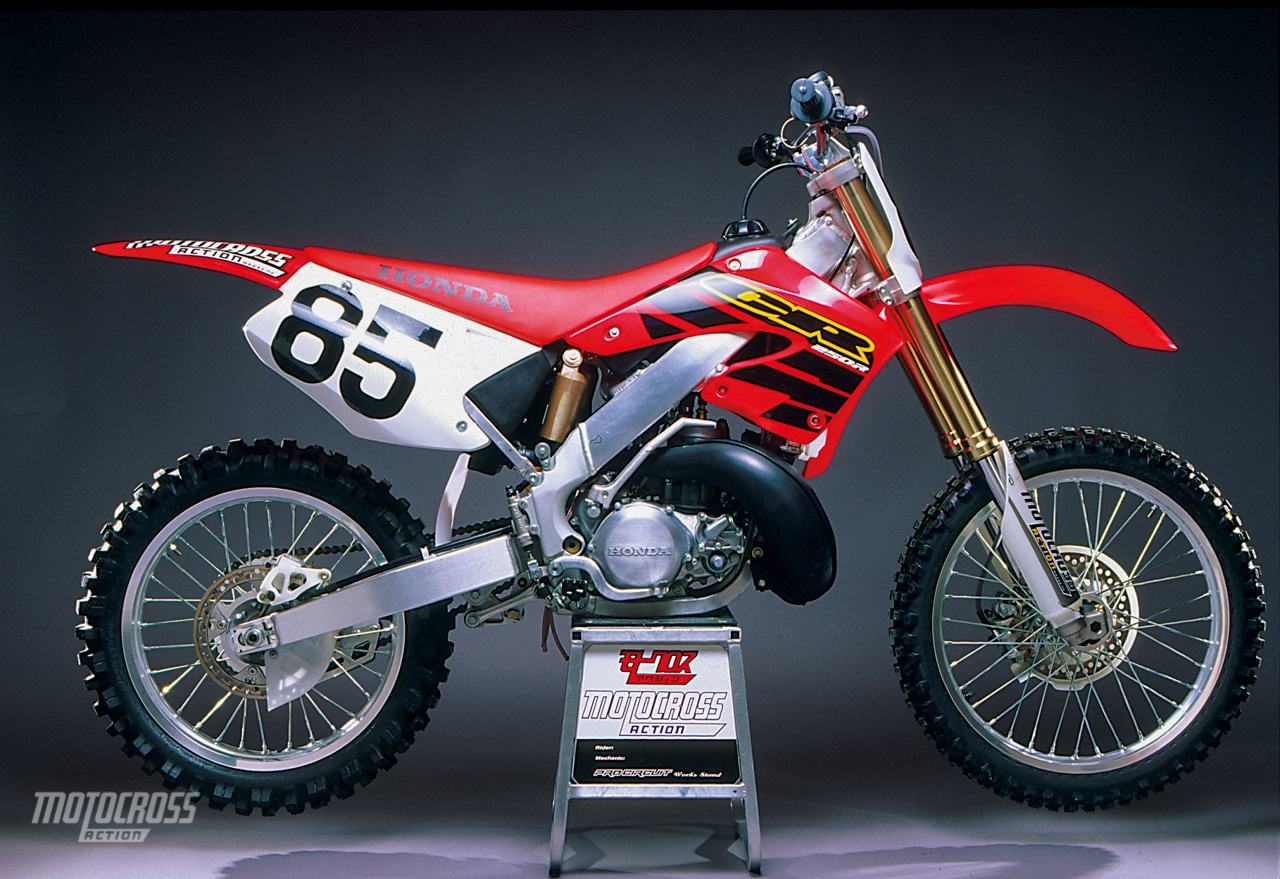 This article is from the April 2000 issue of Motocross Action Magazine. Subscribe now.
This article is from the April 2000 issue of Motocross Action Magazine. Subscribe now.
If you own a Honda CR250, it will be worth your while to spend the next few minutes with the MXA wrecking crew. We’ll provide a step-by-step guide to achieving more pliable suspension action, a balanced ride and more authoritative power deliver.
These must-do fix-it tips offer a cumulative end result. The adjustments are designed to work together and help each other complete the package. If you only make half of the changes, you’ll only reap half the gain.
JETTING FOR SUCCESS
The best CR jetting is a 182 main, 50 pilot and 715-289 needle in the second clip. The stock brass is 180 main, 48 pilot and third clip position.
POWER VALVE CLEANING
When installing the cylinder, it’s necessary to manually push the valve to the closed position and watch that the linkage fork at the bottom of the cylinder lines up over the actuating pin on the case (the right side valve cover needs to be removed).
Frequently remove the right side power valve cover and check the condition of the valves and linkage. Rotate the valves by hand and feel if they are sticky. Contact cleaner will not remove built-up varnish, so if the valves are gummy, a valve disassembly is necessary. Scrape the residue with a deburring tool and clean all rotating areas with a mild Scotch-Brite pad. With the cover off rev the engine and check for smooth movement.
PISTON AND RING LIFE
If you clean the filter and run the right jetting, the bike can be raced for an average of 15 hours before replacing the piston and rings.
CHEAP PERFORMANCE GAINS
Run four exhaust spacers between the pipe and manifold (#18309-K23-600). The increased head pipe length makes power delivery noticeably torquier off the bottom.
Hot rod shops sell a 10mm spacer for the exhaust cover that increases the resonance chamber’s volume and boosts power delivery off the bottom. These spacers work and are used by Team Honda.
REED PETALS
The ultra-thin, standard reeds work well, but have a life span of approximately seven hours. The lower, right side petal will chip first. If you’re a revver, inspect the pedals every two weekends of riding. You might consider switching to Boyesen reeds for a longer lifespan.
AIR CLEANER MAINTENANCE
The filter cage has a pin that lines up with a hole at the top of the box’s sealing ring. If the pin isn’t lined up, there will be a quarter inch gap where dirt can get in and ruin the engine. Before tightening the wing nut, try spinning the filter. If it won’t spin, it’s right.
GEARBOX LUBE
The CR’s aluminum drive plates quickly contaminate the gearbox oil. Change oil after every race. Any quality 10/40 motor oil will suffice, but Honda recommends you use Hondalube oil GN4 10-40 or 80/90 HP Gear Oil. (Both oils are identical. The viscosity scale for motor oil is different than the one used for gear oil). The MXA wrecking crew runs Maxima gear oil.
MXA’S WEIRD GEARING
The hot gearing is 14/52 (13/50 stock). To use this gearing, it’s necessary to run a smaller CR80 chain roller at the top. Take the original top roller and use it at the bottom. If you don’t change the rollers, the shock will be even harsher over square-edge bumps.
COUNTERSHAFT SPROCKET CARE
If you remove the countershaft sprocket bolt, be sure to torque it properly and use 272 red Loctite.
SPROCKET BOLT ALERT
Secure the sprocket bolts with red Loctite. Check them after every moto. If the sprocket has been removed a couple times, replace the nuts and bolts. Carry a spare set in your toolbox.
CHINTZY CHAIN
The stock CR chain is chintzy. The MXA wrecking crew uses an expensive DID gold chain (#4029435). It lasts four times longer and seldom requires adjustment.
CR250 CHAIN ADJUSTMENT
If the chain is adjusted too tight, the rear suspension action will be harsh. If it’s too loose, the rear suspension will feel sloppy. Maintain 25mm to 35mm of chain slack, measured just behind the back of the swingarm’s top chain slider.
WATCH THOSE CHAIN ADJUSTERS
Apply anti-seize to the chain adjuster bolts. When the bolts lose their factory coating, the threads seize solid in the swingarm. Replace the stock nuts with the self-locking variety.
SWINGARM AND CHAIN GUIDE PADS
If the chain guide pad wears too far, the chain will saw through the guide. Worn swingarm pads will alter chain adjustment and the chain torque’s anti-bottoming effect.
SHOWA FORK FIXES
Switch to heavier 0.44 kg/mm springs and start with 372cc of oil. Go down as much as 20cc from there. The stock spring is 0.43 kg/mm and stock oil volume 382cc. Run the compression clicker at ten to 14 clicks out and the rebound on ten to 15 out.
BUILD YOUR OWN FORK OIL DISPLACERS
Since tuning with oil volume is a bigger hassle than tuning by oil height, the MXA test crew makes oil displacers to aid with initial setup. We cut six, 25mm-long sections of one-inch diameter, Schedule 40, PVC pipe (and slit them lengthwise). Then, we slip these PVC spacers on the cartridge rod (above the spring seat). Each PVC clip raises the oil buy 5cc (by reducing air volume). MXA pours 352cc of oil in each leg and then tunes the oil height, adding or subtracting PVC clips. Once we find the ultimate height, we remove the spacers and replace with the appropriate volume of oil–although we never get around to replacing the PVC clips.
MEASURE THE FORK SPRINGS
Showa fork springs are often too short. Use steel preload spacers to bring the overall measurement up to spec. The overall spring length should be 495mm.
CR250 FORK OIL
Hondalube HP oil measures as a 7-weight and Showa SS7 comes in as a 5-weight. The HP oil is a better lubricant to use until the temperature drops to 65 degrees or below–then we use SS7.
SLIDE THE FORKS UP
The standard tube height is flush with the top of the crown. Slide the forks up in the clamps 3mm to accommodate the stiffer fork spring. Some riders go as much as 5mm, but there is a chance that the tire will hit the underside of the fender.
CR250 FORK AXLE INSTALLATION
If the left fork leg isn’t centered over the axle, it will bind the fork action. To keep this from happening, follow these steps: (1) Install the axle and tighten the nut (if the axle starts to spin, snug one of the left pinch bolts.) (2) Tighten both right pinch bolts. (3) With the left inch nuts loose, lightly insert a screwdriver in the axle clamp split to force it open. (4) Pump the fork a few times. Remove the screwdriver and tighten the two left axle clamp bolts.
CR250 SHOCK TIPS
Replace the stock 4.8 kg/mm with a 5.15 kg/mm spring. Set the sag between 98mm and 100mm, the rebound between 10 and 12 clicks out, low-speed compression from 8 to 10 clicks out and high-speed compression at 1 to 1-1/2 turns. The more time you put on the shock, the heavier you need to set the rebound.
LUBRICATE THOSE PIVOTS
Take the triple clamp assembly, swingarm and linkage apart, clean and then liberally lube the bearings and seals with a grease that repels water (Maxima, Bel-Ray or Honda Pro Molybendum.) The pivots are greased lightly from the factory. Relative to how much the bike is pressure washed or how often it’s used in mud, follow a one to six month re-lube schedule.
REAR BRAKE INFO
Above the swingarm axle there is a loop in the rear brake hydraulics that likes to trap air. Unbolt the caliper and hold it higher than the master cylinder when bleeding the rear brake. Don’t top the rear brake fluid reservoir after the hydraulics are bled. Before filling the master cylinder, pry the pads open, mount the caliper over the rotor and operate the pedals to reset the caliper pistons. Now, top off the reservoir. You can even bleed the back brake with the rear wheel up on a tailgate so that it is higher than the front wheel. Use a DOT 4 fluid.
Bleed the front and rear brakes often if you are a crasher. It’s possible for air to mix throughout the hydraulics as the bike cartwheels down the track.
CR250 REAR BRAKE LEVER
In deep berms, the lever can catch and flex outward. The constant side-to-side motion loosens the brake pivot bolt. Red Loctite the bolt and check it after each moto.
SPOKES DURING BREAK-IN
Frequently check the tension of the spokes when the wheels are new. It will take three rides for the spokes to seat. Honda uses steel nipples which take a fair amount of abuse.
CR250 CABLE ROUTING
Don’t change the standard carburetor vent hoses or cable routing positions. Check the operation and free play of all controls when turning the handlebar from stop to stop. This is very important if you have an adjustable bar mount or taller bar. Make sure that the kill switch wires aren’t pulled taut or caught between the steering stop.
BAR CLAMP REMEDIES
If you can’t get the bar to sit straight in the clamps after a crash, check the following: (1) The bar clamps could be twisted out of line. (2) The clamp bolts could be bent. (3) The rubber damping cone could be torn.
CR250 VIBRATION CONTROL
If the CR250’s vibration is still getting the better of you, try this tip. Remove the triple clamp and spray insulation foam into each frame spar (by shooting it through the relief hole inside the steerer tube. When the spray foam dries, cut off the excess, reinstall the clamps and go ride with a noticeable reduction in vibration.



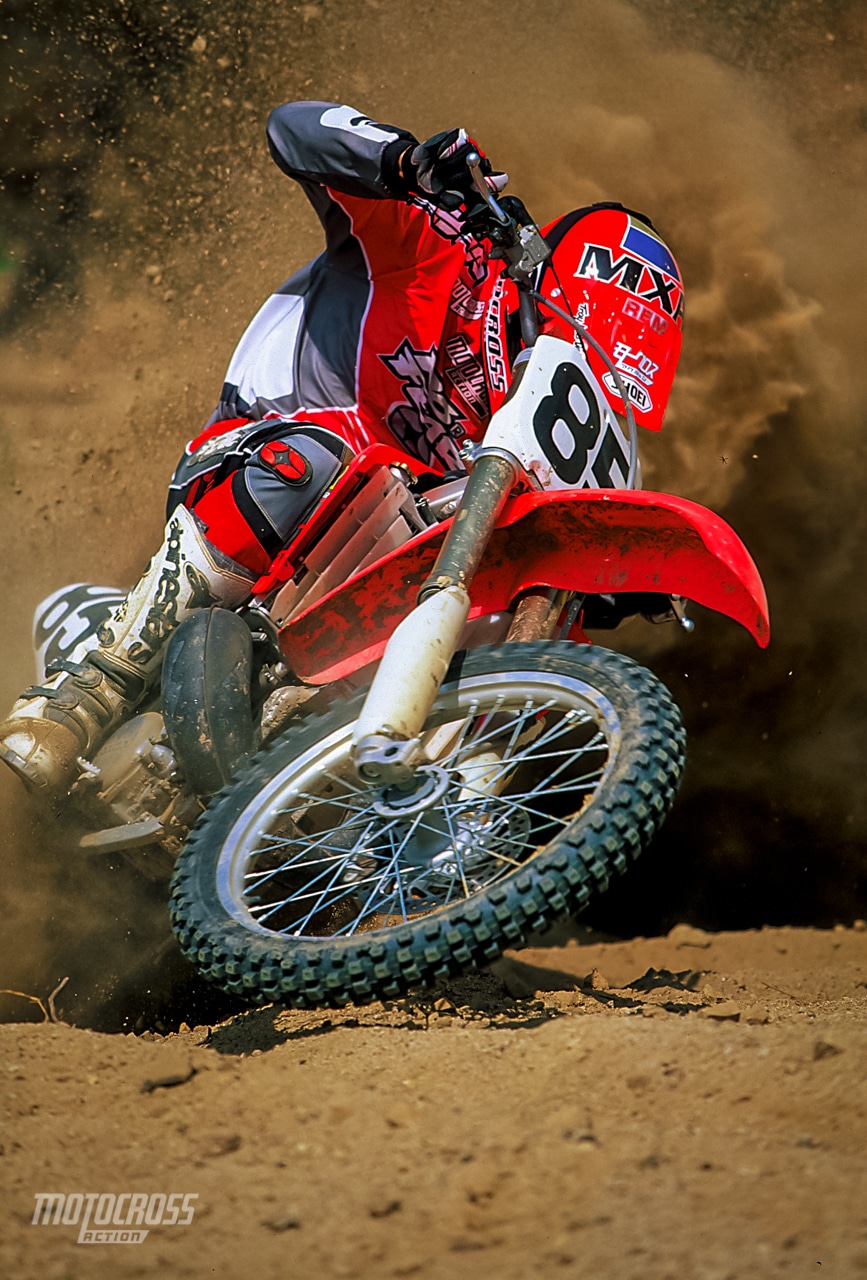

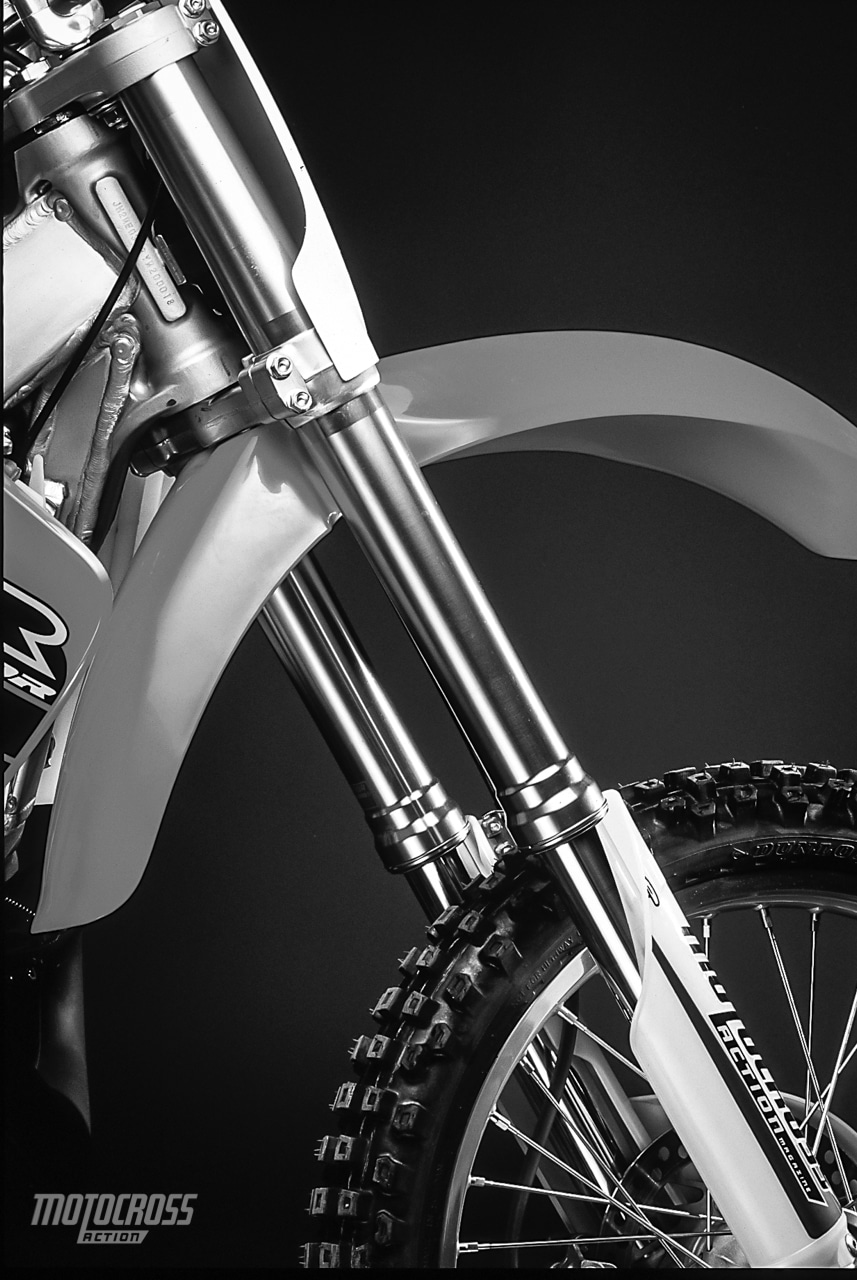
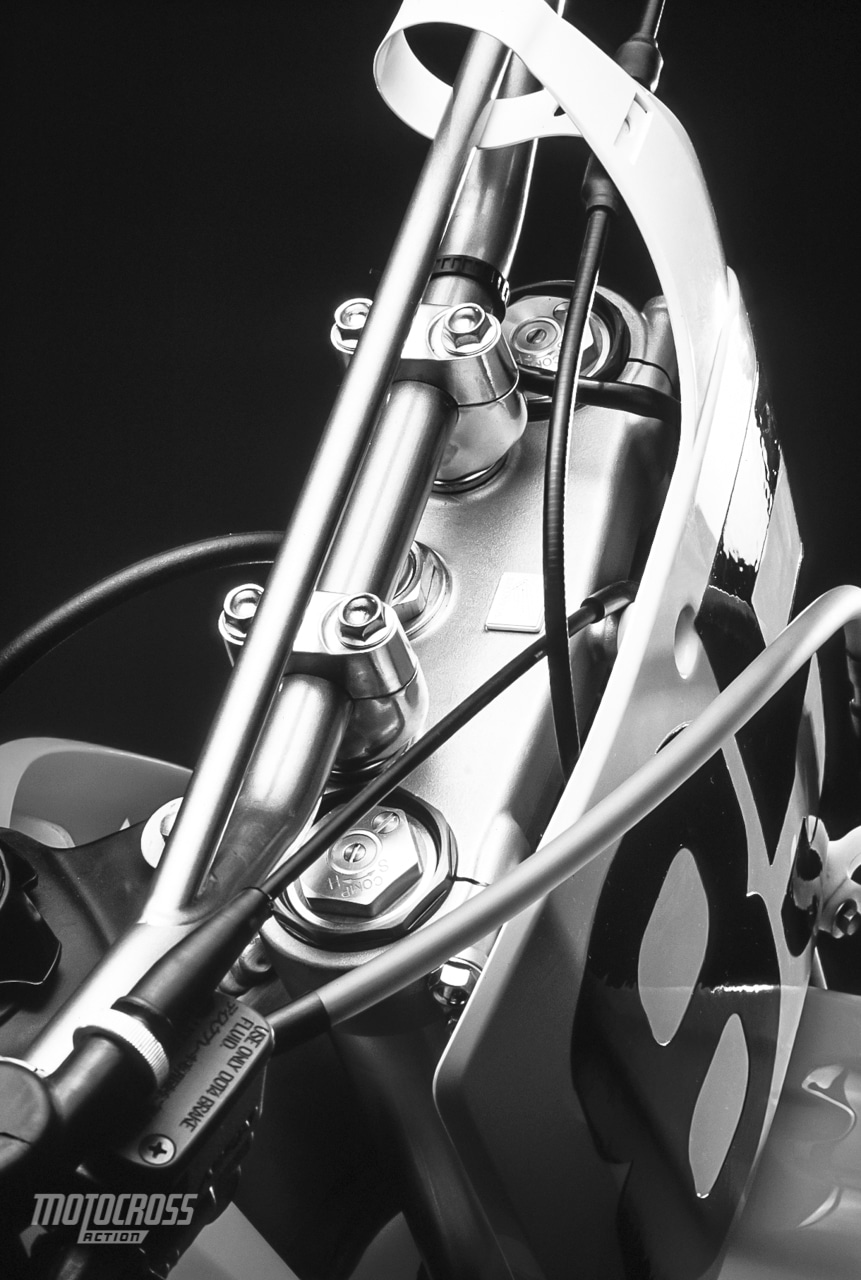
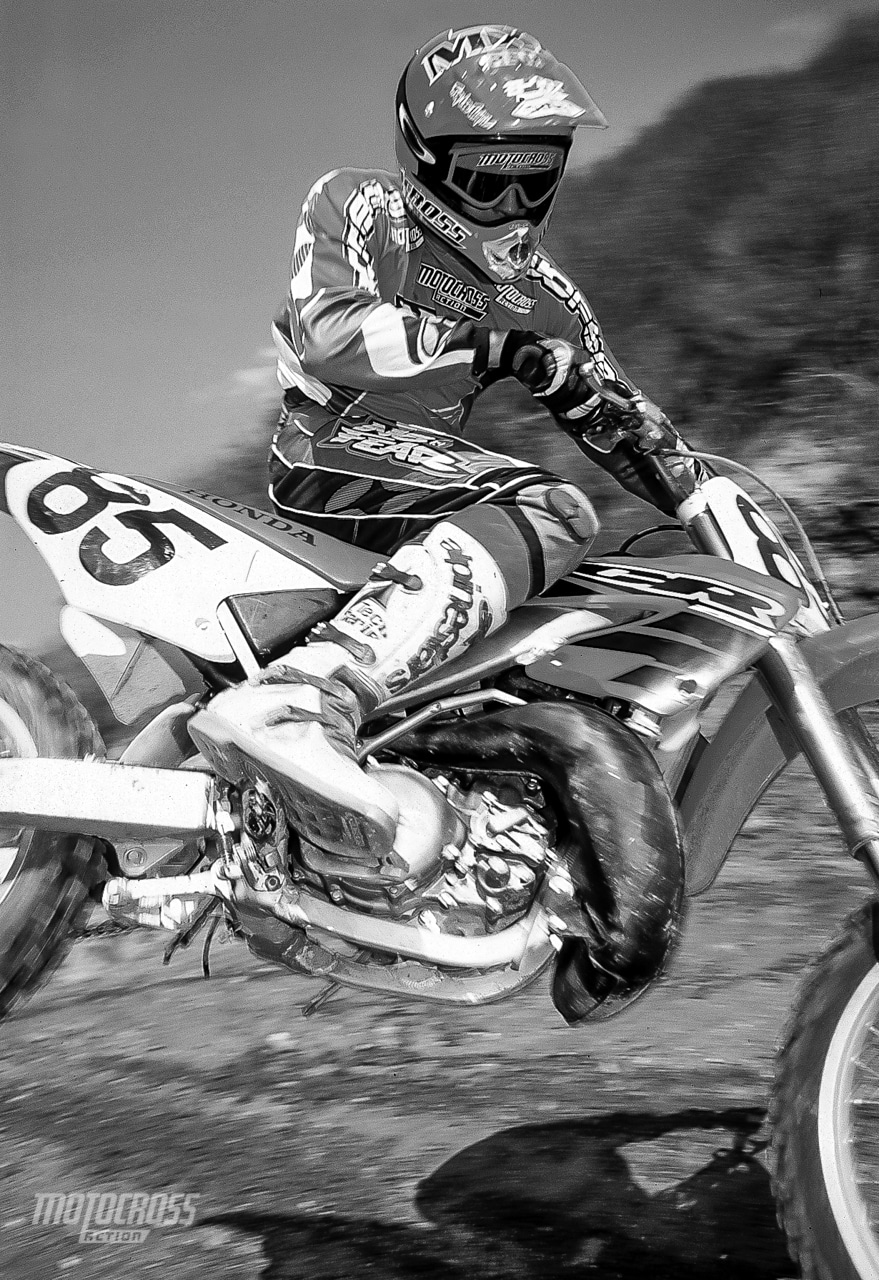



Comments are closed.